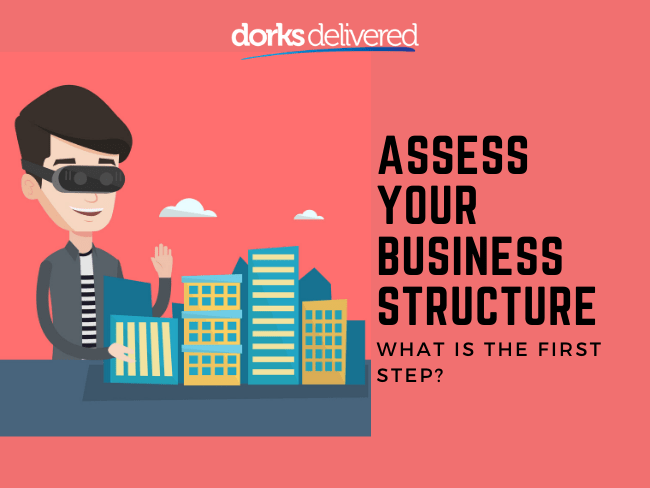Have you ever been part of restructuring an organization? As what Heraclitus said, “The only constant in life is change.” And in this modern world, whether a complex or simple change happens, this highly affects all aspects of our daily routine. Restructuring a business is tough, and it takes a great deal of careful planning and execution but at the same time, we also need to remain adaptable to the ever-changing environment and maintain its competitiveness. Therefore, we must deal with these changes differently according to the situation. If you are considering to restructure your business or make organizational changes in the near future, there are a few things you must consider. In this episode, Tim Wilshire shares tips on how to restructure your business properly.
Josh: G’day everyone out there in podcast land. We’ve got an awesome guest for you, we’ve got Tim Wilshire from CTBS here, who is a networking number cruncher who podcasts people’s perspectives.
We’ve got him on to talk about how to restructure your business and when the right time is to do that. So Tim, first question, how do you know when to do that? I know you’ve come across businesses that are started as sole traders and other businesses are looking for asset separation and all sorts of stuff. How do you know when the right time is?
Tim: Okay. Thanks very much, Joshua and hello listeners. But as far as restructuring is concerned, obviously, one thing that I’ve done plenty of over the last 20 years at my business is restructuring our clients from one structure to another. I guess, like a lot of the answers to questions these days, the answer is, it depends. Okay? You’re probably hearing that quite a lot, this is the new 2020 thing, it depends.
So it depends on what the different situation is. So if they’re in the wrong structure, to begin with, and it’s not expensive to change them into the correct structure, that’s usually a good time to restructure. So let’s say they’re a sole trader, let’s say they’ve been going in business for a very short space of time and income is starting to come in the door, something that may potentially sell one day, then you can no longer be a sole trader anymore. It doesn’t make sense to stay being a sole trader because number one, you’re not protecting your assets. If you’ve got assets in your own personal name, all of a sudden those assets are at risk and the more at risk, the more risky behaviour that you’re doing, the more at risk those assets are when you’re a sole trader, so that’s definitely a time to look at structures.
If you’re not out of the sole trader structure, get out of that particular structure. And there are two alternatives that we sort of look at, whatever the structuring is, do you want to try it as a company or do you want to trade as a trading trust? Or a combination of both types of structure as well. So that’s one, I guess, a time where it’s quite common when it comes to restructuring. Another time might be, okay, I’m in the trading trust at the moment, but I’m basically making too much money and it’s no longer viable unless I’ve got a company structure. A company structure meaning, I can type my money and I can grow the business. So, a trading trust structure may no longer be applicable to those circumstances because selling the business because you have fewer options. If you’re in a company structure, you’ve got more options, easier ways to add and subtract business partners, shareholders, et cetera.
If it’s a trading trust, usually good for a smaller operation, up to a couple hundred thousand dollars of profit. Once you get beyond that, a company is certainly worth considering. So that’s another time to consider, okay, what’s it going to cost to restructure from that structure to that? What are all the processes that I need to do? It doesn’t make sense to do that. So that’s probably the two main ones you’re sort of looking at changing structure because of the circumstances, the current structure doesn’t fit what you’re currently doing, and your medium to long term objective.
IT doesn’t have to be expensive. If you’re starting a business and need reliable IT support and services, fill out the form to learn more about $1 IT services.
Josh: And when you say trading trust, discretionary trust and trading trust are the same things?
Tim: Yep, yes, exactly.
Josh: Cool. So, you then have cascading setups where you have trusts that own companies, which I think you touched on a little bit there. And then you have companies that are sitting by themself and then you have some people that have multiple companies and asset companies, asset protection. Why would you have that?

So certainly if you’ve got clients that are big enough that are turning over more than a couple of million dollars a year, really need to review their structures and say, okay, well, are we in the right sort of structure? Is there something going on that we can do a bit more separation? Can we protect our assets better than what they are? The moment it’s all in one basket, and that company goes down, then what? What’s the plan of attack if that were to happen? If you’ve got another company over here doing something, important stuff, whatever, you might be able to drop one or the other. So it just gives you a few more options. Yes, it’s more of a cost. Yes, it’s more of an administration to be able to manage more than one, but at least you’re doing things. Separating and separating the risks.
Josh: Okay. And you’ve talked about going forward, bigger, better, or potentially more complication and more administrative overhead. Are there any times that you would be pulling that back in? Going from a company structure and then going back to a sole trader or something like that.
Tim: You never go back to a sole trader, unless you’re not really running a business anymore. But you may sort of downsizing your operations in it if you’ve got too many different structures. And I’m thinking of a client right now who had way too many different things going on, different trusts. Once you stop using that particular trust, you can close it down, sort of getting rid of it. So obviously if it’s not getting used, get rid of it. You should be able to probably get rid of the different things that aren’t getting used properly. Obviously, if your sales are coming down, you’re sort of downsizing the business, getting rid of staff for whatever reason, because you’re downsizing the business. And then do you need that if there’s no staff? I mean, all of a sudden you don’t necessarily need that.
IT doesn’t have to be expensive. If you’re starting a business and need reliable IT support and services, fill out the form to learn more about $1 IT services.
Josh: Who opens the conversation to the structure? Is this something that people should be already aware of themself, where they’re talking to their accountant about it, or does the accountant say, “Hey, look, you’ve turned over a million dollars as a sole trader, something’s not adding up here? Let’s look to restructure this.” Or is this something that they sort of need to jump on their own steam? Or maybe they’re listening to the podcast to work out the answer. But who should be opening up that conversation?
Tim: I think us, as accountants and advisors, should be opening up that conversation with our clients. We’ve got to be proactive, we’ve got to see where the opportunities exist for those clients to get things right. And we’ve got to take advantage of those opportunities. So get the clients to think that they need to take advantage to get those opportunities.
Josh: For us, I started off as the transitioning periods, as you’ve said, is pretty much what we did. So when everyone was 14 and nine months old and they were off getting their McDonald’s job, I was getting my tax file number and registering my first ABN number. So as a sole trader, I started off just on 15 and continued through as a sole trader for a few years until I had the trust and then the company trusts and then the company trusts and then another company, to have asset protection. And then another company again, which was around some of the different grants and advantages that you can have that are pushed out to companies that are not trading as a trust. You can optimise your tax with multiple businesses and structures, but what would be the reason you’d want to have more than one company? If not for asset protection or a government grant or something like that.
Tim: Why would you have more than one? Obviously, if you’ve got more than one business operation actually going, you want to separate them in different trading locations. There might be one location here, there might be one location there, it doesn’t always make sense to put them in the same envy. That way, if things can be sold separately, you want to be able to treat them separately. Every different division of the business, you probably should have it in its own entity. And you should try to steer away from grouping them together as well. The reason you don’t want to group them together is, it’s definitely messier when it comes to returning your tax. Also, if you’ve tried to group GST, that’s messy. And also if you’re grouping them, then you’re losing out on some benefits sometimes as well. A good example is the government’s recent cash flow boost. If you’ve got just one company, then you’re only going to get one lot of cashflow boosts. Whereas if you’ve got two companies, you’re going to get more benefits rather than just one.
IT doesn’t have to be expensive. If you’re starting a business and need reliable IT support and services, fill out the form to learn more about $1 IT services.
Josh: Fair enough. And you did touch on something there about if it’s being sold.
So when it comes down to exit strategies, if people are looking to sell their business, when’s the right time to restructure. When is the right time? You don’t want it to look like you’ve cooked the books or changed the books around or done something funky. You want to make sure there’s some historical evidence there that the business is profitable, that everything is going as you would expect it to be. When is the right time to restructure if you are looking towards an exit?
Tim: You don’t necessarily want to restructure until it’s no longer useful. So it doesn’t make sense to restructure too soon. So make sure you get to what you’re trying to do before you make that choice cutting these off.

Tim: Yeah, I guess all the reasons that I’ve sort of gone through. Growing, make sure you’re structuring correctly, protecting your assets. You need to minimise tax, exactly what you said. And when it comes to the next step, you get to another step, keep reviewing. What’s the benefit of bringing in another entity? And everything else that we’ve sort of discussed there as well. Are we running more than one business operation and can we separate them out? I see clients that shove three different car washes into one entity. They’re all at different locations, it doesn’t make sense.
Josh: I’m going to say something that I think a lot of people, maybe even yourself, are going to disagree with. Companies are generally pretty straightforward to set it up. There are not too many things you can stuff up. If there’s one company and then there’s another company, the company as the Pty LTD, decides the division of shares and the number of directors, et cetera, et cetera. The actual company itself is a reasonably straightforward container.
Tim: Well, I guess it’s very easy to set companies up, yes. Making sure that it’s set up right still requires a bit of skill. Who are the shareholders? The shareholders are a very important part of the company and how those shares are owned are very, very important. Putting mum and dad as a shareholder is not always the best way to do it. So is setting up a trust to own the shares, a better option? That’s usually what we’d recommend. We’d say, look, you should want more flexibility. It’s not owned by you as an individual, it’s in the trust. Then we’re talking asset protection 101, as far as making sure that things are done right.
Josh: When it comes down to trust though, it seems like there’s a bit more of a grey area than a company. It seems that whenever I’ve gone to a bank or any lending Institute, they hear that you’re running under a trust, they seem to think there’s more complication. How come trusts inherently appear to be more complicated than a company?
IT doesn’t have to be expensive. If you’re starting a business and need reliable IT support and services, fill out the form to learn more about $1 IT services.
Tim: I mean, with trusts, once you sort of whirl into it, it’s probably not as common.
To some, it may not be as complicated as what you may think. So obviously it’s a great structure. We’re talking about protecting assets, we’re talking about planning the long term beneficiaries, kids, children, that all make sense to find out about what all the particular roles are. You just need to know what those roles actually are in a trust, and a lot of people don’t know about that unless they read it. So once there’s a bit of understanding, then you say, well, this is not as bad as what we thought. But again, it’s complicated because it’s obviously different to that of an individual sole trader, different from a partnership, different from a company. So I guess that’s the stigma behind it, that it is more complicated. Just requires a bit of understanding in order to make it not feel as complicated as what its outward appearances would suggest.
Josh: Were they more open to abuse in the past? Or has that been sort of tightened down a bit?
Tim: Self-assessment is obviously huge. So, there’s a lot of trusts given to people to do the right thing. And when it comes to trust, there’s no exception. So just because you set up a trust, doesn’t mean you’re going to get an audit or anything like that. Obviously, the audits flags are going to arise if things just don’t match up or add up when the ATO is looking at the back system. The government from time to time, have said they don’t want trusts, but they’ve never done anything about that. The Labour government, before the last election, tried to make some fairly drastic changes. I guess that’s where we are with that at the moment. It’s not like it hasn’t flown under the radar, but they haven’t done anything about it.
Josh: What would be the advantages to not having the structure, where you have a company and then trust and instead, you’re just running solely as a company?
Tim: You’re talking about the shareholder situation and also the difference between having a trust as a shareholder and having an individual as a shareholder. So, the biggest issue with having an individual as a shareholder is, company makes money, makes a lot of money, it pays all its tax, there’s only one person that can actually end up with that dividend. If they want to declare a dividend or get forced to declare a dividend in some cases, then that goes to one person’s particular taxable income. And that could really jump their income quite high, depending on when and how they have to deal with that situation and the profit and all that sort of stuff.
Whereas a trust, at least you got more flexibility. You’ve got the flexibility to look at the rest of the family group. Can we allocate that dividend to somebody who’s on a lower tax income? It makes sense. Three or $400 you spend extra to set up a trust. It’s worth it because, yes, you might have to do some dividends and you might have to split that and do another tax return but at the end of the day, it will more than pay for itself.
IT doesn’t have to be expensive. If you’re starting a business and need reliable IT support and services, fill out the form to learn more about $1 IT services.
Josh: So if I was to be a single bachelor or bachelorette and have no one that I can distribute anything to, have no business partners, I own 100% of the shares, still having it through a discretionary trust, would still put an extra level of protection there.
Tim: It does protect the number of assets that are attributed to yourself because it’s a trust that owns the company. That means that that’s not a personal asset that belongs to you. Whereas if you were the only shareholder, whatever the equity in that company, is effectively your asset. If the trust has that there, then if it’s not your personal asset, so it usually can be helpful in things like bankruptcy.

Tim: Appreciate you doing this, Josh. There’s something I just wanted to finish off with. In 2020, and as it was in 2014 or 2015, if you’re going into business with somebody else, set it up as a company. Yes, the shares held 50/50 by different trusts or what have you, but if you go into business with somebody else, make sure it’s a company. It just allows a lot more flexibility, allows a lot more growth. It sort of ticks of all the common goals that two partners going into business should be looking at when they go into business together.
Josh: If you were having a Pty or LTD and you had a couple of business owners, is there a restriction or any complication if you had one of those business owners that were not from Australia?
Tim: We have clients where companies are wholly owned by overseas companies, it’s always possible. What’s required is, the operation to be here at the central management. So the central management being in Australia, one of the directors must be an Australian resident. That’s the requirement. The shares can be owned 100% by overseas entities or 50/50 here.
Josh: That’s good to know. Hopefully, anyone out there that is thinking about their structure, has had that aha moment and is thinking a little bit more about it, how to set it up properly and yeah, jump down to you guys to get it all sorted.
Tim: Thank you very much.
Josh: Cool. Well, anyone out there in podcast land, if you’ve enjoyed this, make sure to jump across to iTunes, leave us a review, give us some love and stay healthy. Stay good in this COVID climate.
[module-379]




























